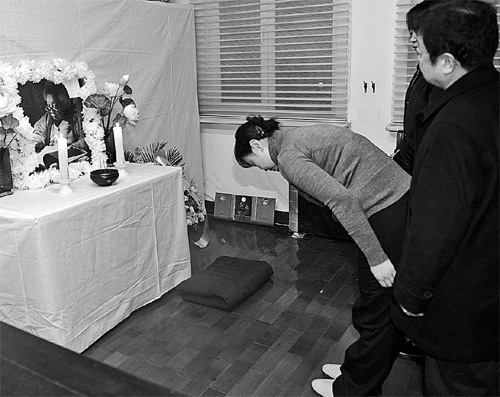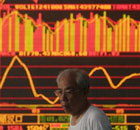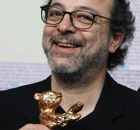Profiles
Brushes with Chinese history
By Qiu Yijiao (China Daily)
Updated: 2010-02-23 07:09
 |
Large Medium Small |
Zhang Ding spent 70 years at forefront of China's art scene
Renowned Chinese artist Zhang Ding, described as "a combination of Picasso and traditional Chinese painting", died on Sunday at the age of 93.
 People pay their last respects to Zhang Ding(seen in inset), a famous artist who died on Sunday in Beijing. [China Daily] |
Devoted to painting for more than 70 years, Zhang was famous for integrating Chinese folk painting and Western contemporary art. He was also open-minded in trying various art forms and critics called him one of China's greatest artists of the 20th century.
"It is hard to give Mr. Zhang a title because he excelled in many fields," says Wang Luxiang, a well-known art critic and television documentary producer. "His versatility in cartoons, paintings, murals, calligraphy and landscape paintings made him a legend in the art circle."
Zhang taught himself traditional Chinese painting at an early age and first made himself known as a cartoonist during the War of Resistance against Japanese Aggression (1937-45). Determined to become a true patriot, he published his works in newspapers, rousing the public to protect their country.
He later moved on to decorations and murals. Zhang took charge of the art design of the founding ceremony of New China in 1949, responsible for the layout of Tian'anmen square. After that, he designed New China's first set of commemorative stamps and the emblem of the Chinese People's Political Consultative Conference.
"Zhang was the image designer for New China," Wang commented, adding that Zhang not only provided a brand new look for China domestically, but also contributed a lot to building the country's international image.
During the 1950s, Zhang was the major designer of China's pavilions at expositions held in Leipzig, Prague, Moscow and Paris. His designs impressed overseas audiences so much that at the Paris exposition several French millionaires even offered to buy the whole pavilion.
Zhang also produced China's first wide-screen color animation, Prince Nezha's Triumph Against Dragon King, in 1978 and painted a mural for the Beijing Capital International Airport with the same name a year later.
But Chinese paintings were always special to Zhang. As an educator, he was the first vice-president of the former Central Academy of Arts and Design, now the Academy of Arts of Tsinghua University, in the 1960s. Zhang studied Chinese folk art for more than a decade and found a lot of similarities with Western impressionism and abstractionism.
"Zhang always encouraged us to be creative. He mixed Chinese classic painting skills with Western contemporary genres, which was quite bold at that time," recalled his student Liu Jude, now a professor in the academy.
Liu says Zhang became a fan of Pablo Picasso at the age of 17. "In Zhang's costume paintings, he liked to use eye-catching colors and abstract painting language. It reminds people of Picasso's works."
The two met each other in 1950 and Zhang later visited museums in Europe, absorbing the essence of Western art.
In recent years, Zhang shifted his focus to pure-ink Chinese painting and insisted on going outside, painting nature under harsh weather conditions. His students say his doctor always tried to stop him because of his age and health problems, but Zhang never took the advice seriously.
"Zhang kept saying to me that he was an ordinary worker in the art world. Only hard work can produce good pieces," Liu says, adding that he was moved not only by Zhang's painting but also his devotion to art.
At the end of January this year, Tsinghua University established a research center for Zhang Ding's art.
"Zhang is a key master in contemporary Chinese art history. His works and spirit are worthy of our respect forever and should be passed down to the younger artists," art critic Wang says.







